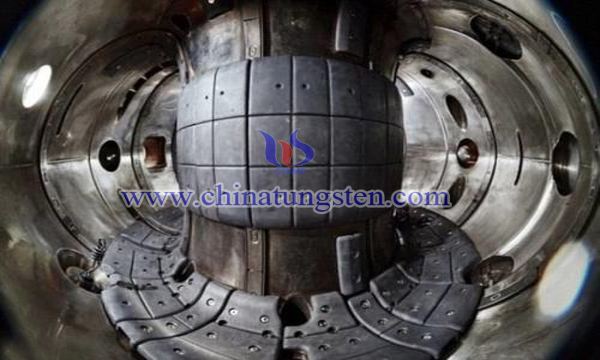Tungsten Coating Applied on Nuclear Fusion Reactor
- Details
- Category: Tungsten Information
- Published on Monday, 15 July 2019 01:04
With the upcoming construction of the International Thermonuclear Experimental Reactor (ITER), the study of plasma-facing materials (PFM) used in ITER has become a popular and frontier research direction, as it is a key component of fusion reactor.
After many years of research, ITER has selected tungsten as the main divertor target material, and carbon-carbon composites as the rest part. If the high retention problem in the redeposited carbon layer is not well solved, in the late stage of ITER During the operation phase, it is possible to use tungsten as the ITER all divertor target material.

The main reason for this is that the low-Z material has a short life span for the first wall of the fusion reactor. The low Z material (C, Be) will be sputtered and etched away by more than 3mm per year; while the high Z tungsten annual sputtering corrosion yield is less than 0.1mm, if the first wall is replaced every five years, the total Corrosion yield does not exceed 0.5mm. It is obviously a good choice to use high Z tungsten and its alloys as PFM. Even though the first wall material of the ITER device is tentatively Be, it is the first wall and the starting limiter material in the later stage of the deuterium and tritium operation. Reservation plan. Therefore, for future steady-state operation of the fusion reactor, high Z tungsten will become the most promising candidate wall material.
For high-power, steady-state operation of the fusion device, the real-time removal of high heat load is a necessary condition for the safe operation of the first wall, which not only imposes strict requirements on the PFM but also on its connection with the heat sink. Future fusion reactors should be operated in a steady state. The necessary conditions for steady-state operation are: the thermal load deposited on the first wall can be removed in real time, and the heat flux of the high heat load components is usually 5-10 MW/m2. . The melting point of tungsten is the highest among all metals. Tungsten has been reconfirmed as the most promising candidate wall material in the future fusion reactor, but it is brittle at room temperature, easy to oxidize during processing, and easily contaminated by impurities, damaging tungsten coating. The layer acts as a material facing the plasma. Copper-chromium-zirconium alloy is an ideal heat sink material because of its high thermal conductivity and excellent thermodynamic and mechanical properties. However, the elastic modulus of tungsten and copper alloy differs greatly from the thermal expansion coefficient (more than 4 times). How to achieve such a large-area connection of materials with two different properties is quite tricky.
Recently, the researchers used a spraying scheme to spray a thick tungsten coating on a first wall component or a copper alloy heat sink in a nuclear fusion device. In a vacuum plasma spraying apparatus, a CuCrZr alloy heat sink is used as a substrate. Vacuum-plasma coating of 200-300 mesh NiCrAl powder was used as the intermediate matching layer on the substrate, and vacuum plasma sprayed tungsten powder was used as the thick tungsten coating on the matching layer. Active water cooling was adopted during the whole spraying process. The temperature of the sheet is controlled at 100-500 °C. The final effect is sufficient to meet the life requirements of the existing national EAST divertor target, 2 to 3 mm thick tungsten tile on the first wall of ITER and future fusion reactors. In the active cooling heat load test, the long-term effect of the thermal load of 5 to 10 MW/m 2 can be withstood in a steady state. At the same time, the process is relatively simple and reliable, and can be widely applied to high heat load components such as the divertor target plate and the limiter of the current nuclear fusion experimental device.
- Tungsten Manufacturer & Supplier, Chinatungsten Online: www.chinatungsten.com
- Tungsten News & Prices of China Tungsten Industry Association: www.ctia.com.cn
- Molybdenum News & Price: news.molybdenum.com.cn
- Tel.: 86 592 5129696; Fax: 86 592 5129797; Email: sales@chinatungsten.com



 sales@chinatungsten.com
sales@chinatungsten.com